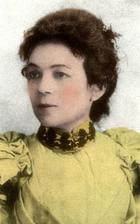
Barbara Baynton was born in Scone, a town in the state of New South Wales, Australia, in 1857.
She, however, always maintained that she had been born five years later, in 1862, and this was not the only biographical information that would falsify. Even her grandchildren believed that she had been the illegitimate daughter of two Irishmen who fell in love on the ship that took them to Australia, whose names were different from those of their true parents. He also changed his father's profession and made him go from carpenter to landowner. This fiction was conceived when Baynton moved to Sydney after her first husband left her with three children in her care. In 1890, the day after she obtained a divorce, she married her second husband, Thomas Baynton, with whom she began a new life. His social promotion was immediate, and soon some of his stories began to see the light in The Bulletin magazine. Six of them would meet in the anthology Studies of the Wild, published in London in 1902, in Gerald Duckworth and Company, after several Australian publishers rejected her for her unkind descriptions of the country's interior regions. There is not the slightest trace of national pride in her texts, nor is there that romantic exaltation for the lives of the inhabitants of the most depopulated areas, which permeated the predominant Australian literature in the 1890s. Her second husband died in 1904, and She began investing in the stock market and in antiques, which would lead to a passion for the world of jewelery that persisted until her death. He published Human Toll, his only novel, in 1907, and in 1917 Cobbers was released, a new anthology of stories that added two to those already collected in Studies of the Wild. During World War I she lived in England, and in 1921 she married her third husband, Baron Headley. Despite the brevity of her literary output, Barbara Baynton's highly personal vision has been recognized as one of the most significant in Australian literary creation. He died in Melbourne on May 28, 1929.




